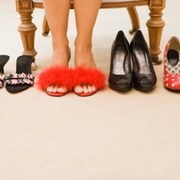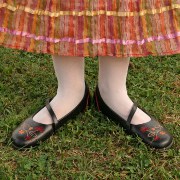Unlike those who trade their feet for fashion, people with flat foot have a different kind of problem that is not self-inflicted. Flat foot is when the arch in your foot collapses, or never formed leaving the sole of your foot on the ground.
Like everything else in life, genetics plays a big role in this medical condition; however there are a lot of other causes for flat feet such as injury, weight gain, arthritis or poor biomechanics. It is startling how many people get flat foot from either not learning to walk correctly as a child or grow up practicing bad biomechanic habits and not even realizing it.
Flat foot is also very common in infants and children because their arch hasn’t developed yet in the early stages of life. It is not out of the ordinary for doctors to suggest having your child learn to walk barefoot, especially over uneven terrain to help build the arch. Sounds odd, but there is proof it aides in normal growth of an arch. Think about cavemen; they probably all had beautiful arches from rock climbing and hunting barefoot.
But seriously, if your child’s arch doesn’t develop by early teens, there is definitely cause for concern and you should reach out to a podiatrist. Just like you check to see if you child is outgrowing their shoes (to avoid hammer toe) you should be keeping tabs on the arch in their foot. Although most of the time flatfoot cannot be prevented, it can and should be treated as soon as possible.
Lucky for some there are two types of flat foot. I say lucky because if you have what is known as flexible flatfoot, you may not experience too many complications with this condition. Off-weigh-bearing, you have an arch, but when you are standing the arch goes away. This is fairly common and with a little stretching and the right footwear many people will go through life with no complications that effect their daily lives.
The complications lie within the rigid flat foot. This means whether you are standing on your feet or not, you do not have an arch. Not only does this leave you walking a little funny, but it can snowball into many other problems with your back, knee’s, ankles, hips and spine. The older you get, or the more pressure you put on your feet, the worse your problems can be.
Check back Wednesday where we will examine the lifestyle of those with rigid flat foot vs those with flexible flat foot, and what you can do at home to help yourself if you are experiencing this condition.






Add a Comment6 Comments
I have written about children's feet and shoes -- here is a good article on choosing shoes for children -- http://www.americaspodiatrist.com/2009/12/what-are-the-best-shoes-for-children-the-answer-may-surprise-you/
January 13, 2010 - 4:29amHere is an article on footwear and your feet ---http://www.americaspodiatrist.com/2009/10/the-top-3-ways-wearing-shoes-harms-our-feet-%e2%80%93-and-what-we-can-do-about-it/
This Comment
Dr. Nirenberg - Thanks for writing and sharing these articles. For some reason the second link didn't pick up, so I'm adding it below. This is great information! Pat
http://www.americaspodiatrist.com/2009/10/the-top-3-ways-wearing-shoes-harms-our-feet-%E2%80%93-and-what-we-can-do-about-it/
January 13, 2010 - 6:39pmThis Comment
Thanks for the correction, Pat! A little off topic, but readers of this site may be interested to learn how the female foot is unique and quite different from the male foot --
http://www.americaspodiatrist.com/2009/08/the-womans-foot-unique-beautiful-and-prone-to-problems/
January 13, 2010 - 7:12pmThis Comment
Dr. Nirenberg - I LOVED your article. It does get old hearing that we women cause our own foot problems, and I've never seen such a detailed, fascinating scientific explanation of why our feet are the way they are. I also really like your list of women's health resources after your article. Thanks for your continued support of women's good health and for being part of our site! Pat
January 14, 2010 - 6:28pmThis Comment
Pat - Thank you for the comments. Females have more foot problems than males. Sadly, many doctors often treat the woman's foot and man's foot as one in the same. This could be okay, but it is not always the best thing for the patient.
January 17, 2010 - 7:55amThis Comment
Thanks Samara,
I have what you would call a flexible flat foot. I've had it forever and it has fortunately never ever interfered with anything I have done. It's good to know I may be able to avoid for my son to also have flat foot since I always thought it was strictly genetic and if you were meant to have it you'd have it. I appreciate learning something new today!
January 12, 2010 - 6:42amThis Comment